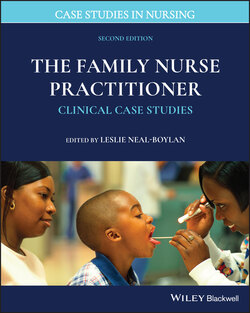Читать книгу The Family Nurse Practitioner - Группа авторов - Страница 24
ОглавлениеCase 2.6 Diarrhea
By Mikki Meadows‐Oliver, PhD, RN, FAAN
SUBJECTIVE
David, an 11‐month‐old infant, presents to the office with complaints of watery diarrhea for 1 day. David is accompanied by his mother. In addition to the diarrhea, he has had vomiting for 1 day and a fever for 2 days. His maximum temperature at home was 102°F (rectal). David has not vomited today, although the fever continues and the diarrhea seems to be getting worse. He has had at least 10 diapers with diarrhea since yesterday. David’s mother is unsure of his urine output because each diaper is so full of stool. No blood or mucus has been noted in the stool. His mother believes that a rash is starting on his buttocks due to the diarrhea. She knows that another child in the day care center had diarrhea a few days ago. No one at home has any similar symptoms.
Yesterday, David completed a course of amoxicillin for otitis media. David’s mother states that earlier in the week she began to introduce whole milk into his diet and that she also gave him Indian take‐out food with a strong curry flavor. She is concerned that one of these factors may have caused or contributed to David’s diarrhea. Further review of systems reveals that David has had decreased solid food and soy formula intake since yesterday and that he has been sleeping more than usual.
Birth history: David is the product of a 41‐week gestation. He was delivered vaginally without complications. During the pregnancy, his mother had no falls or infections. She was in a car accident when she was 6 months pregnant and had to receive an X‐ray of her right wrist. There was no break in the wrist, and she was told to take Tylenol for pain. David’s mother did not drink alcohol, take prescription medication (other than prenatal vitamins), use tobacco products, or use illicit drugs. His birth weight was 3480 g, and his Apgar scores were 7 at 1 minute and 8 at 5 minutes.
Social history: David was born to a 39‐year‐old mother. He is an only child. He lives at home with his mother. She works as a psychologist with her own private practice. David’s father is not involved. There are no pets or smokers in the home.
Family medical history: The health history of David’s father and the paternal grandparents is unknown. David’s mother is positive for Crohn disease. His maternal grandmother has a history of Type 2 diabetes, and the maternal grandfather has a history of prostate cancer.
David is currently taking no prescription or herbal medications. His mother gave him an over‐the‐counter antiemetic, Emetrol®, to help reduce nausea and vomiting. She has not given him any antidiarrheal agents. David has no known allergies to food, medications, or the environment. He is up to date for required vaccinations, but he did not receive a rotavirus vaccination due to a recall of the vaccination.
OBJECTIVE
David’s vital signs were taken in the office today. His weight is 6.8 kg, and his length is 69 cm. David’s temperature is elevated at 38°C (rectal). When observing David’s general appearance, he is alert and consolable by his mother when crying.
Skin: The skin on David’s buttocks is mildly erythematous. There is no cyanosis of his skin, lips, or nails. There is no diaphoresis noted. David has good skin turgor on examination.
HEENT: David’s head is normocephalic. His anterior fontanel is open and flat (0.5 cm × 0.5 cm). Upon examination of David’s eyes, his red reflexes are present bilaterally and his pupils are equal, round, and reactive to light. There is no discharge noted, and tears are present when crying. David’s external ear reveals that the pinnae are normal. On otoscopic examination, the tympanic membranes are pink bilaterally with positive light reflex. Bony landmarks are visible, and there is no fluid noted behind the tympanic membrane. Both nostrils are patent. There is no nasal discharge, and there is no nasal flaring. David’s mucous membranes are noted to be moist when examining his oropharynx. He has 4 teeth present without evidence of caries. There are no lesions present in the oral cavity.
Neck: David’s neck is supple and able to move in all directions without resistance. There is no cervical lymphadenopathy.
Respirations: Respiratory rate is 28 breaths per minute, and lungs are clear to auscultation in all lobes. There is good air entry, and no retractions or grunting are noted on examination. No deformities of the thoracic cage are noted.
Cardiovascular: Heart rate is 110 beats per minute with a regular rhythm. There is no murmur noted upon auscultation. Brachial and femoral pulses are present and 2+ bilaterally.
Abdomen: Hyperactive bowel sounds are present throughout. David has diffuse tenderness on abdominal palpation. His abdomen is mildly distended; there is no evidence of hepatosplenomegaly.
Genitourinary: Genitourinary examination revealed normal male genitalia. David is circumcised, and his testes are descended bilaterally.
Neuromusculoskeletal: David was noted to have good tone in all extremities. He has full range of motion of all extremities. His extremities are warm and well perfused. Capillary refill is less than 2 seconds. David’s spine is straight.
CRITICAL THINKING
1 Which laboratory or imaging studies should be considered to assist with or confirm the diagnosis?___Complete blood count (CBC)___Stool culture___Electrolyte levels___Hydrogen breath test___Lactose tolerance test
2 What is the most likely differential diagnosis and why?
3 What is the plan of treatment, referral, and follow‐up care?
4 Are there any demographic factors that should be considered?
5 Are there any standardized guidelines that should be used to assess or treat this case?
